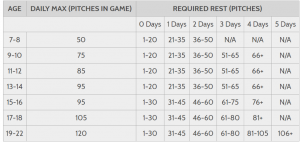Spring training is in full swing right now. Professional baseball players have migrated south to start honing their skills and getting ready for the long baseball season that lies ahead. Similarly, youth baseball and softball programs are also starting practice to get ready for the upcoming season. Softball and baseball have continued to grow in popularity with more than 2.4 million children playing baseball worldwide. Along with this increase in these athletes, injury rates – particularly in baseball pitchers – have increased.
Over the years, USA Baseball and other similar organizations have been developing rules to try and decrease these climbing injury rates. Before 1996, baseball had inning limits and rest requirements, which have since evolved to more specific rules about number of pitches thrown. USA baseball has developed a campaign called "PitchSmart." The goal of this campaign is to give guidelines in each age group for pitch counts and rest days along with recommendations on warm ups and types of pitches to try and decrease injury. Below is a table from MLB.com with the latest pitch counts for youth baseball.
A few other guidelines from the American Sports Medicine Institute developed to avoid injury include:
- Don't pitch with fatigue! If an athlete shows signs of fatigue they should be taken out.
- No overhead throwing for 2-3 months per year
- Avoid pitching on multiple teams at a time
- Pitchers should not also play catcher
- Learn good throwing mechanics early
Pitch counts are a great thing and can really help decrease injury rates. BUT—coaches need to follow them! A survey showed that only 43% of coaches were able to correctly answer questions about pitch counts and 19% allowed players to play with known arm fatigue. The rules will only work if coaches are knowledgeable and rules are followed. Talk with your coaches to make sure they are familiar and are adhering to these guidelines.
Unfortunately, softball doesn't have specific published guidelines similar to baseball. STOP sports injuries (a worldwide group aiming to make things safer for kids) has recommended following similar pitch count guidelines as those used in baseball. This is probably a good guideline for now until more research can be done.
Go to http://m.mlb.com/pitchsmart for more information and age related guidelines.
The post Pitch Counts: Why Are They Important for Your Baseball/Softball Player? appeared first on ChildrensMD.
http://ift.tt/2oKzyOb


Δεν υπάρχουν σχόλια:
Δημοσίευση σχολίου